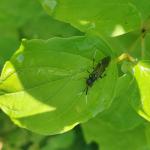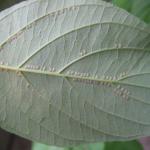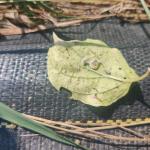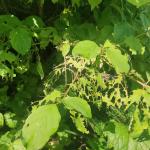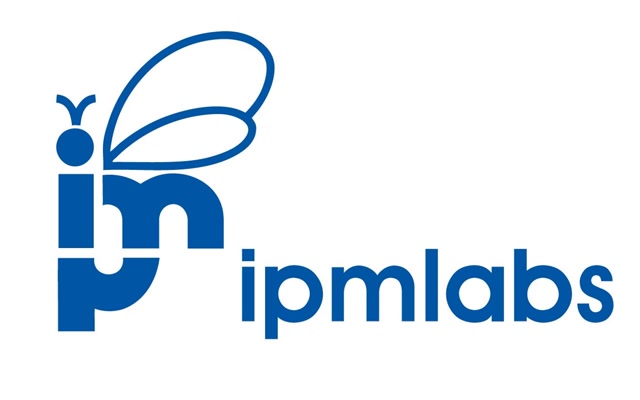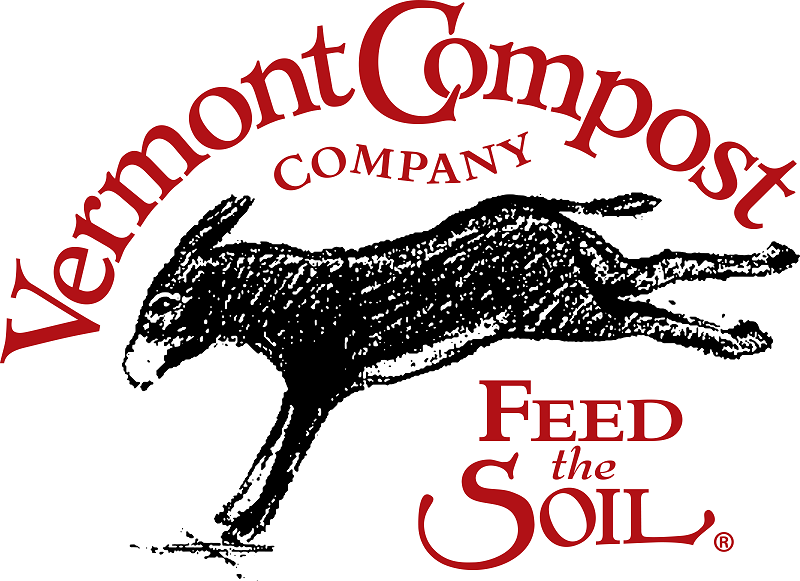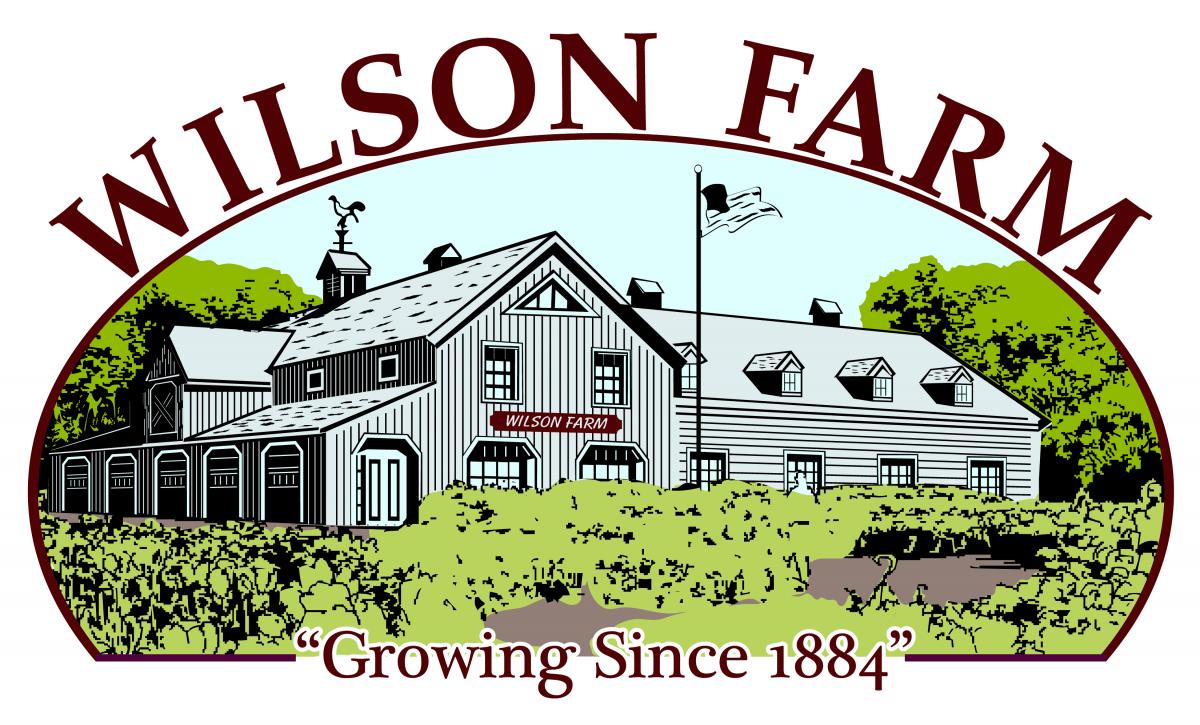To print this issue, either press CTRL/CMD + P or right click on the page and choose Print from the pop-up menu.
Click on images to enlarge.

Crop Conditions
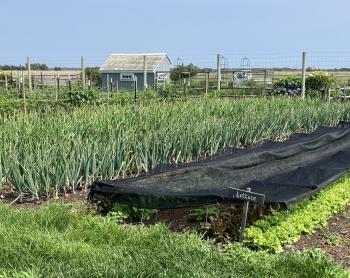 Eggplants, peppers, and tomatoes are coming in and customers are happy! Fresh onions are about ready too, and the last garlic is out and curing in barns and greenhouses. It has been a week of intense thunderstorms across much of the state, with rain most evenings and sites in western MA getting pummeled by several short but intense storms over the last few days. Climate change experts have predicted for many years that changes to Northeast summers will include higher temperatures and more frequent, intense rainstorms, which perfectly describes what we seem to be experiencing. Properly curing garlic (and soon, onion) crops is difficult in wet weather. From the folks at the Ontario Ministry of Agriculture, Food, and Rural Affairs: “In most years, when the ambient air’s relative humidity is low, increasing the temperature greatly increases the water holding capacity of the air. This year, the air has been humid, and already close to being saturated. Therefore, increasing the temperature of the air will not add much more water holding capacity. As a result, it will take a longer amount of time to remove excess moisture from the crop. Speed up curing by adding dehumidifiers or air conditioners to pull as much moisture from the crop as quickly as possible.”
Eggplants, peppers, and tomatoes are coming in and customers are happy! Fresh onions are about ready too, and the last garlic is out and curing in barns and greenhouses. It has been a week of intense thunderstorms across much of the state, with rain most evenings and sites in western MA getting pummeled by several short but intense storms over the last few days. Climate change experts have predicted for many years that changes to Northeast summers will include higher temperatures and more frequent, intense rainstorms, which perfectly describes what we seem to be experiencing. Properly curing garlic (and soon, onion) crops is difficult in wet weather. From the folks at the Ontario Ministry of Agriculture, Food, and Rural Affairs: “In most years, when the ambient air’s relative humidity is low, increasing the temperature greatly increases the water holding capacity of the air. This year, the air has been humid, and already close to being saturated. Therefore, increasing the temperature of the air will not add much more water holding capacity. As a result, it will take a longer amount of time to remove excess moisture from the crop. Speed up curing by adding dehumidifiers or air conditioners to pull as much moisture from the crop as quickly as possible.”
It was great to see some Martha’s Vineyard growers yesterday at our Morning Glory Farm twilight meeting! Next up, we’ll be at Bardwell Farm in Hatfield on August 2, to hear about irrigation water quality, Bardwell’s automated irrigation system, and an on-farm trial for managing Phytophthora blight in peppers. Register in advance HERE so we can order enough food, and see you there!
Pest Alerts
Cucurbits
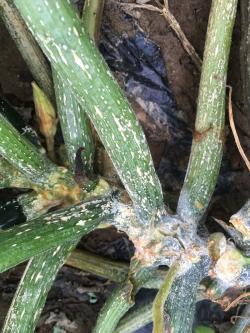 Plectosporium blight was observed on zucchini this week. This is a fungal disease that causes dry, white lesions that are elongate on cucurbit stems and rounder on fruits and leaves. The fungus overwinters on crop residue, and spores produced on infected crops are spread to new fields by wind. Crop rotation and choosing well-draining soils for cucurbit crops can help mitigate this disease. Fungicides must be applied before symptoms appear for effective control. Labeled fungicides include several combinations of DMIs (FRAC Group 3) and strobilurin (FRAC Group 11) fungicides including Quadris Top (Groups 11 +3), Aprovia Top (3 + 7), Inspire Super (3 + 9), Merivon (7 + 11), Cabrio (11), and Flint (11). Rotate between fungicide classes.
Plectosporium blight was observed on zucchini this week. This is a fungal disease that causes dry, white lesions that are elongate on cucurbit stems and rounder on fruits and leaves. The fungus overwinters on crop residue, and spores produced on infected crops are spread to new fields by wind. Crop rotation and choosing well-draining soils for cucurbit crops can help mitigate this disease. Fungicides must be applied before symptoms appear for effective control. Labeled fungicides include several combinations of DMIs (FRAC Group 3) and strobilurin (FRAC Group 11) fungicides including Quadris Top (Groups 11 +3), Aprovia Top (3 + 7), Inspire Super (3 + 9), Merivon (7 + 11), Cabrio (11), and Flint (11). Rotate between fungicide classes.
 Choanephora rot was observed in Hampden Co. in summer squash this week. This is a weak fungal pathogen that infects developing squash fruit under wet conditions. The blossom ends of infected fruit develop lots of fuzzy white and black sporulation. The fungus is common in most soils. There is no chemical control for Choanephora rot. When field conditions dry out, the disease will cease to be an issue.
Choanephora rot was observed in Hampden Co. in summer squash this week. This is a weak fungal pathogen that infects developing squash fruit under wet conditions. The blossom ends of infected fruit develop lots of fuzzy white and black sporulation. The fungus is common in most soils. There is no chemical control for Choanephora rot. When field conditions dry out, the disease will cease to be an issue.
Squash vine borer (SVB) pheromone trap captures are continuing to drop, signaling the end of the first flight, although one trapping site in Sharon County is still catching quite high numbers (Table 1). First generation larvae are feeding inside the stems of thick-stemmed cucurbits now. They will pupate within the plant or in the soil. In cooler years, these pupae will overwinter and adults will emerge next spring. In warmer years (and this year has certainly been warm!), the adults will emerge in late September or early October and the second generation larvae often bore into winter squash fruit, making the fruit unmarketable and often leading to secondary rots. We will continue monitoring SVB trap counts and will alert you here if it looks like a second generation of adults is emerging before winter squash harvest.
|
Trap location
|
SVB
|
|---|---|
|
Whately
|
2
|
|
Leominster
|
2
|
|
Sharon
|
19
|
|
Westhampton
|
3
|
|
Spray thresholds: Thick-stemmed cucurbits only. 5 moths/week for bush-type cucurbits. 12 moths/week for vining cucurbits.
|
|
Nightshades
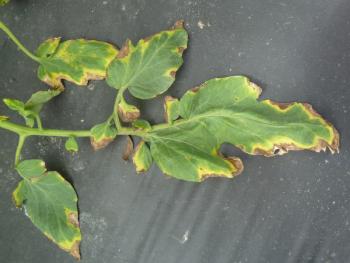
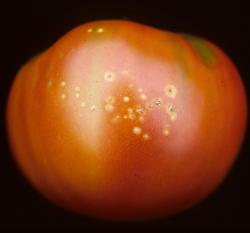 Bacterial canker was diagnosed on tomatoes this week in a field in Franklin Co. This disease most often arrives on farms via infected seed, then overwinters on crop residues and on trellising materials. Leaf margins on infected plants turn brown, often in V-shaped patterns extending in from the margin. Lesions will often have yellow borders. All ages of leaves will be affected. Small “bird’s-eye” spots, with dead tissue at the center and a yellowing halo, develop on fruit. The causal bacteria infect the plant’s vascular system; as the disease progresses, the plant may wilt due to plugged vascular tissue. This disease can be very difficult to manage, especially if you’re re-using trellising materials. It’s important to get suspect plants correctly diagnosed—contact us at umassveg@umass.edu or 413-577-3976 or submit a sample directly to the UMass Plant Diagnostic Lab. Copper or copper + mancozeb can help slow the spread of bacterial canker but must be applied early and often. See the Outdoor Tomato or Greenhouse & High Tunnel Tomato disease sections of the New England Vegetable Management Guide for labeled materials.
Bacterial canker was diagnosed on tomatoes this week in a field in Franklin Co. This disease most often arrives on farms via infected seed, then overwinters on crop residues and on trellising materials. Leaf margins on infected plants turn brown, often in V-shaped patterns extending in from the margin. Lesions will often have yellow borders. All ages of leaves will be affected. Small “bird’s-eye” spots, with dead tissue at the center and a yellowing halo, develop on fruit. The causal bacteria infect the plant’s vascular system; as the disease progresses, the plant may wilt due to plugged vascular tissue. This disease can be very difficult to manage, especially if you’re re-using trellising materials. It’s important to get suspect plants correctly diagnosed—contact us at umassveg@umass.edu or 413-577-3976 or submit a sample directly to the UMass Plant Diagnostic Lab. Copper or copper + mancozeb can help slow the spread of bacterial canker but must be applied early and often. See the Outdoor Tomato or Greenhouse & High Tunnel Tomato disease sections of the New England Vegetable Management Guide for labeled materials.
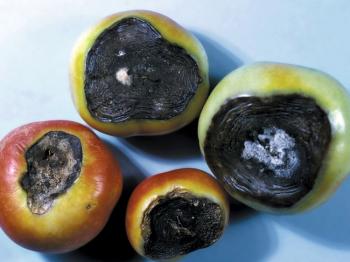 Blossom end rot (BER) is starting to show up in tomato crops now, either as a result of soils that are low in calcium, or in fields where tomato root function has been reduced by waterlogged soils. BER is a physiological disorder caused by calcium deficiency in the blossom end of tomato fruit. Calcium is transported from the soil and into the plant with water, so when soil is too dry or when root function is compromised (e.g. by disease or waterlogged soils), calcium is not moved into the plant and tissues become deficient. BER is less commonly caused by actual calcium deficiency in the soil. The dead fruit tissue caused by calcium deficiency is initially light brown and leathery but is often colonized by the saprophytic fungus Alternaria alternata, which produces copious black sporulation. In dry years, BER can be minimized by providing sufficient and even water to tomato crops—if a crop is on drip irrigation, we recommend using at least 2 lines of drip per bed to provide enough water. In wet years, there’s little to be done to prevent root disfunction in waterlogged soils.
Blossom end rot (BER) is starting to show up in tomato crops now, either as a result of soils that are low in calcium, or in fields where tomato root function has been reduced by waterlogged soils. BER is a physiological disorder caused by calcium deficiency in the blossom end of tomato fruit. Calcium is transported from the soil and into the plant with water, so when soil is too dry or when root function is compromised (e.g. by disease or waterlogged soils), calcium is not moved into the plant and tissues become deficient. BER is less commonly caused by actual calcium deficiency in the soil. The dead fruit tissue caused by calcium deficiency is initially light brown and leathery but is often colonized by the saprophytic fungus Alternaria alternata, which produces copious black sporulation. In dry years, BER can be minimized by providing sufficient and even water to tomato crops—if a crop is on drip irrigation, we recommend using at least 2 lines of drip per bed to provide enough water. In wet years, there’s little to be done to prevent root disfunction in waterlogged soils.
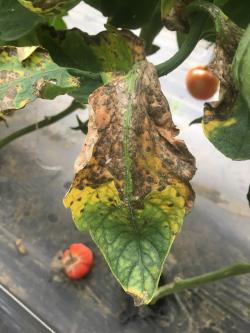 Septoria leaf spot: Foliar diseases are showing up on tomatoes now, including a report of Septoria leaf spot. This is one of the most common fungal diseases of tomato. It causes small leaf spots (a couple mm in diameter) with small black speckles (fruiting bodies called pycnidia from which spores are produced) that are barely visible with the naked eye. Disease begins in lower leaves and moves upward as it progresses. The pathogen overwinters in infested crop residue and can be seed-borne. It is spread from the soil to plants and between plants by splashing water. Incorporate crop residues promptly and thoroughly after harvest to encourage crop residue breakdown. Avoid working in fields when foliage is wet. Fungicides can effectively control Septoria, but applications must begin as soon as symptoms appear and re-applications must be made regularly. For labeled materials, see the Outdoor Tomato and High Tunnel & Greenhouse Tomato disease sections of the New England Vegetable Management Guide. Copper is the best option for organic growers.
Septoria leaf spot: Foliar diseases are showing up on tomatoes now, including a report of Septoria leaf spot. This is one of the most common fungal diseases of tomato. It causes small leaf spots (a couple mm in diameter) with small black speckles (fruiting bodies called pycnidia from which spores are produced) that are barely visible with the naked eye. Disease begins in lower leaves and moves upward as it progresses. The pathogen overwinters in infested crop residue and can be seed-borne. It is spread from the soil to plants and between plants by splashing water. Incorporate crop residues promptly and thoroughly after harvest to encourage crop residue breakdown. Avoid working in fields when foliage is wet. Fungicides can effectively control Septoria, but applications must begin as soon as symptoms appear and re-applications must be made regularly. For labeled materials, see the Outdoor Tomato and High Tunnel & Greenhouse Tomato disease sections of the New England Vegetable Management Guide. Copper is the best option for organic growers.
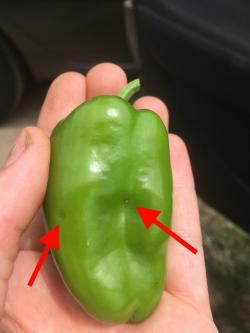 Pepper maggot oviposition marks and eggs were observed in a field of hot peppers in Franklin Co. this week. The oviposition marks look like small dimples in the fruit, sometimes with a pinprick of dead tissue at the center. The eggs are inserted into the flesh of the pepper and can be hard to find. The resulting larvae will feed within the pepper fruit then drop to the soil to pupate. Infested fruit are unmarketable and often become infected by secondary fungi. Some farms struggle with this pest while other farms may never see it. If you have this pest on your farm, management must start when egg-laying first begins in mid-July. Cherry peppers are a preferred host and can be planted in border rows for easy monitoring. As soon as oviposition marks are observed, apply an insecticide. Insecticides need to target the adult flies because the larvae are protected from pesticides inside the fruit. Labeled materials include alpha-cypermethrin (e.g. Fastac), dimethoate, malathion, zeta-cypermethrin (e.g. Mustang), and spinosad (e.g., GF-120 Naturalyte, which is labeled for organic use; note that while this product contains the same active ingredient as Entrust, it is formulated as a bait to attract flies and is a more effective product for this pest). Infested fruit should be removed from the field promptly and destroyed—make sure the larvae are not able to complete their life cycle in infested fruit in a cull pile. Using plastic mulch and weed mat as soil barriers should prevent the larvae from reaching the soil to pupate. See the article in this issue for more information on pepper maggot.
Pepper maggot oviposition marks and eggs were observed in a field of hot peppers in Franklin Co. this week. The oviposition marks look like small dimples in the fruit, sometimes with a pinprick of dead tissue at the center. The eggs are inserted into the flesh of the pepper and can be hard to find. The resulting larvae will feed within the pepper fruit then drop to the soil to pupate. Infested fruit are unmarketable and often become infected by secondary fungi. Some farms struggle with this pest while other farms may never see it. If you have this pest on your farm, management must start when egg-laying first begins in mid-July. Cherry peppers are a preferred host and can be planted in border rows for easy monitoring. As soon as oviposition marks are observed, apply an insecticide. Insecticides need to target the adult flies because the larvae are protected from pesticides inside the fruit. Labeled materials include alpha-cypermethrin (e.g. Fastac), dimethoate, malathion, zeta-cypermethrin (e.g. Mustang), and spinosad (e.g., GF-120 Naturalyte, which is labeled for organic use; note that while this product contains the same active ingredient as Entrust, it is formulated as a bait to attract flies and is a more effective product for this pest). Infested fruit should be removed from the field promptly and destroyed—make sure the larvae are not able to complete their life cycle in infested fruit in a cull pile. Using plastic mulch and weed mat as soil barriers should prevent the larvae from reaching the soil to pupate. See the article in this issue for more information on pepper maggot.
Sweet corn
European corn borer (ECB) trap captures are beginning to rise again at some locations, with a high of 11 caught at one site in Worcester Co. this week (see Table 2). Most of the state is right around 1400 GDDs, which is when the second generation moths are predicted to begin emerging. This generation of moths can lay eggs in a wide variety of crops. See the article in this issue for information on ECB in pepper.
Corn earworm (CEW) trap counts increased again this week, with more growers on 4-day spray schedules. Temperatures have dropped slightly (thank goodness) but we’re still likely to have 2 or more consecutive days above 80°F this week—spray intervals should be tightened by 1 day if so. Do not rely solely on pyrethroids for CEW management. Bt varieties that contain the vip3A gene (e.g. Attribute II, Attribute Plus) will control CEW—this pest is resistant to the other Bt genes.
Fall armyworm moths were captured at 3 out of 14 trapping sites this week. If CEW trap counts are too low to warrant a spray (below 1.4 moths/week, averaged between 2 traps), scout whorl corn for ECB and FAW and spray if 12-15% of plants are infested. A good time to apply a pesticide is when tassels have just fully emerged, to catch the caterpillars before they migrate down from the whorl and tassels into the ears.
| Nearest Weather station |
GDD (Base 50°F) |
Trap Location | ECB NY | ECB IA | FAW | CEW | CEW SPRay interval |
|---|---|---|---|---|---|---|---|
| Western MA | |||||||
| North Adams | 1422 | n/a | - | - | - | - | - |
| Richmond | 1265 | n/a | - | - | - | - | - |
| South Deerfield | 1519 | Whately | 5 | 0 | 0 | 11.5 | 4 days |
| Chicopee Falls | 1563 | Granby | 0 | 0 | 1 | 1 | no spray* |
| Granville | 1330 | Southwick | 0 | 0 | 0 | 5 | 5 days |
| Central MA | |||||||
| Leominster | 1395 | Leominster | 11 | 1 | - | 19 | 4 days |
| Lancaster | 1 | 0 | 0 | 3 | 6 days | ||
| Northbridge | 1415 | Grafton | 0 | 0 | 0 | 12 | 4 days |
| Worcester | 1409 | Spencer | 0 | 0 | 0 | 1 | no spray* |
| Eastern MA | |||||||
| Bolton | 1418 | Bolton | 3 | 3 | 0 | 6 | 5 days |
| Stow | 1431 | Concord | 0 | 0 | 0 | 3 | 6 days |
| Lawrence | 1442 | Haverhill | 0 | 2 | 0 | 0 | no spray* |
| Ipswich | 1411 | Ipswich | 0 | 0 | 0 | 9 | 4 days |
| Harvard | 1406 | Littleton | 4 | 1 | 0 | 3 | 6 days |
| - | - | Millis | 1 | 0 | n/a | 12 | 4 days |
| Sharon | 1380 | North Easton | 0 | 0 | 3 | 20 | 4 days |
| Sharon | 3 | 0 | - | 22 | 4 days | ||
| - | Sherborn | 4 | 0 | 0 | 7 | 4 days | |
| Providence, RI |
1421 |
Seekonk | 0 | 0 | 10 | 3 | 6 days |
| Swansea | 2 | 0 | - | 3 | 6 days | ||
|
ND - no GDD data for this location - no numbers reported for this trap n/a - this site does not trap for this pest * If CEW trap captures are below 1.4 moths/week, scout block for ECB and FAW caterpillars and make a pesticide application if 12% of plants in a 50-plant sample are infested. |
|||||||
| Moths/Night | Moths/Week | Spray Interval |
|---|---|---|
| 0 - 0.2 | 0 - 1.4 | no spray |
| 0.2 - 0.5 | 1.4 - 3.5 | 6 days |
| 0.5 - 1 | 3.5 - 7 | 5 days |
| 1 - 13 | 7 - 91 | 4 days |
| Over 13 | Over 91 | 3 days |
Cut Flower Pest Alerts
Peony
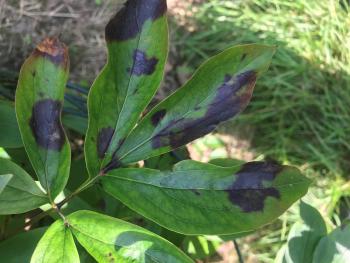 Peony leaf blotch was detected on peonies in Hampshire Co. this week. Leaf blotch, also known as "measles" of peony is caused by the fungus Cladosporium paeoniae. This disease may appear on leaves, petioles, and stems; lesions can coalesce to cause irregular blotches. It is very difficult to stop any disease in the season once it appears. Prevention through proper site selection, cultural management, and good sanitation is by far the most important step in reducing the incidence and spread of disease. Improve airflow by reducing canopy density. Water midday and only at the base of the plant. Remove spent or infected blooms/buds/leaves/stems and make sure to sanitize any pruners with 10% bleach or 70% rubbing alcohol solution between cuts. Add well-composted organic material as a light mulch in early fall to help add nutrients and improve soil quality. Most importantly, cut stems to the ground in late fall or spring to eliminate inoculum. Rake up and remove old plant material. Make sure to prune out affected stems during plant dormancy (winter or early spring before bud break).
Peony leaf blotch was detected on peonies in Hampshire Co. this week. Leaf blotch, also known as "measles" of peony is caused by the fungus Cladosporium paeoniae. This disease may appear on leaves, petioles, and stems; lesions can coalesce to cause irregular blotches. It is very difficult to stop any disease in the season once it appears. Prevention through proper site selection, cultural management, and good sanitation is by far the most important step in reducing the incidence and spread of disease. Improve airflow by reducing canopy density. Water midday and only at the base of the plant. Remove spent or infected blooms/buds/leaves/stems and make sure to sanitize any pruners with 10% bleach or 70% rubbing alcohol solution between cuts. Add well-composted organic material as a light mulch in early fall to help add nutrients and improve soil quality. Most importantly, cut stems to the ground in late fall or spring to eliminate inoculum. Rake up and remove old plant material. Make sure to prune out affected stems during plant dormancy (winter or early spring before bud break).
Dogwood
Dogwood sawfly (Macremphytus tarsatus) larvae and adults were detected on dogwood in Hampshire Co. this week. Dogwood sawfly larvae overwinter in decaying wood, pupate in early spring, and then emerge as adults in late spring or early summer. The adults lay eggs in clusters of 100 or more on the underside of leaves. Eggs hatch and the larvae feed voraciously, skeletonizing leaves. Larval appearance varies greatly throughout instars, so much so that one might mistake them for multiple species. Early instars are translucent and yellow, but as the caterpillars grow they develop black spots (over yellow) and become covered in a white powder-like material. Larvae and their shed skins may resemble bird droppings. The caterpillars can be difficult to manage with insecticides, so removing them by hand is often the most effective management tactic, where practical. For insecticide recommendations, see this article.
Multiple Species (e.g. hydrangea, dogwood)
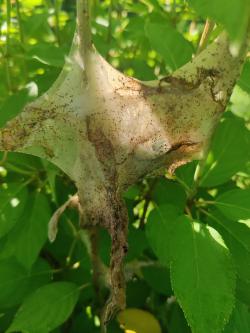 Fall webworm (Hyphantria cunea) was detected on hydrangea in Hampshire Co. this week. Fall webworms are native to North America. Hosts include nearly all shade, fruit, and ornamental trees, except conifers. Adult females lay eggs on the underside of host leaves in March and April. Eggs hatch in late June or early July. Caterpillars are yellowish white or brown, and covered in long, silky gray hairs. Young larvae feed together in groups on the undersides of leaves, first skeletonizing the leaf and then enveloping other leaves and eventually entire branches within their webs. All caterpillar activity occurs within this webbing, which becomes filled with leaf fragments, cast skins, and frass. Fully grown larvae wander from the webs and pupate in protected areas like leaf litter where they will remain for the winter. Adult fall webworm moths emerge the following spring to start the cycle over again. They are approximately ¾-inch long, with either entirely white wings or white wings with black spots. There are 1-2 generations of fall webworm in Massachusetts per year. Fall webworms usually do not cause extensive damage to their hosts. Typically, this insect is mostly a visual concern in the US and does not require chemical management. If in reach, fall webworm webs may be pruned out of trees and shrubs and destroyed.
Fall webworm (Hyphantria cunea) was detected on hydrangea in Hampshire Co. this week. Fall webworms are native to North America. Hosts include nearly all shade, fruit, and ornamental trees, except conifers. Adult females lay eggs on the underside of host leaves in March and April. Eggs hatch in late June or early July. Caterpillars are yellowish white or brown, and covered in long, silky gray hairs. Young larvae feed together in groups on the undersides of leaves, first skeletonizing the leaf and then enveloping other leaves and eventually entire branches within their webs. All caterpillar activity occurs within this webbing, which becomes filled with leaf fragments, cast skins, and frass. Fully grown larvae wander from the webs and pupate in protected areas like leaf litter where they will remain for the winter. Adult fall webworm moths emerge the following spring to start the cycle over again. They are approximately ¾-inch long, with either entirely white wings or white wings with black spots. There are 1-2 generations of fall webworm in Massachusetts per year. Fall webworms usually do not cause extensive damage to their hosts. Typically, this insect is mostly a visual concern in the US and does not require chemical management. If in reach, fall webworm webs may be pruned out of trees and shrubs and destroyed.
--Written by Hannah Whitehead & Angie Madeiras
Contact Us
Contact the UMass Extension Vegetable Program with your farm-related questions, any time of the year. We always do our best to respond to all inquiries.
Vegetable Program: 413-577-3976, umassveg@umass.edu
Staff Directory: https://ag.umass.edu/vegetable/faculty-staff
Home Gardeners: Please contact the UMass GreenInfo Help Line with home gardening and homesteading questions, at greeninfo@umext.umass.edu.
Peppers: Watch for Pepper Maggot & European Corn Borer
Peppers are beginning to be harvested now. In every field, there is some amount of rotting peppers. Knowing the source of the damage is crucial to controlling it. There are diseases that can cause pepper fruit rots, but there are also two insect pests that feed within pepper fruit and cause damage that leads to fruit rots. If you’re culling lots of pepper fruit in the field, we recommend cutting open those fruit to look for pepper maggot and/or European corn borer larvae. This article provides information about how to distinguish between these two pests and how to control them.
Pepper Maggot
Pepper maggot (Zonosemata electa) adults emerge in mid- to late July and are active for several weeks. The larvae feed only on solanaceous plants, including ground cherry, horse nettle, tomato, pepper, and eggplant. Pepper is the preferred host, and green bell peppers and cherry peppers are especially susceptible.
The pepper maggot fly is found throughout eastern North America. Activity of this pest is very localized and varies by farm, region, and year. Many farms never have a problem with this pest. Other farms may have it and not realize it, because it is possible to confuse maggot damage with damage caused by ECB. The best way to detect activity early on is to look for stings on the fruit, and these are easiest to spot on cherry peppers.
Life Cycle and Damage
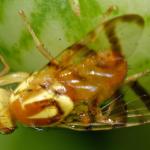
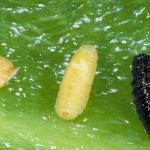 Adult pepper maggot flies are bright yellow and smaller than a house fly, with three yellow stripes on the thorax, green eyes, and clear wings with a distinct banding pattern. The pest overwinters as pupae in the soil where last year’s host plants were. Adults emerge in mid-July and aggregate in forested field edges to mate, then enter the field during the day to lay their eggs. Females insert eggs directly into immature pepper fruit, leaving a small dimple called an oviposition sting or scar. Eggs are light-colored and about 2 mm in length, making them difficult to find inside of fruit. There may be several oviposition scars on a single fruit. After about 10 days, white maggots hatch from these eggs and begin feeding by tunneling within the fruit, especially in the placenta (the spongy white tissue inside the pepper that the seeds are attached to). This results in soft spots on fruit walls and brown mines within. Maggots grow to about ½ inch in length over a period of about two weeks. They do not have a distinct head capsule, unlike ECB larvae which have brown head capsules. When pepper maggots are ready to pupate, usually in late August or early September, they exit the fruit at the blossom end, leaving tiny round exit holes. These holes allow for the entry of soft rot bacteria into the fruit. Sometimes, the oval-shaped brown pupae can be found inside the fruit. Damage is often only detected because of premature ripening or decay of the fruit, or fruit filling with water via the exit holes during washing or hydrocooling.
Adult pepper maggot flies are bright yellow and smaller than a house fly, with three yellow stripes on the thorax, green eyes, and clear wings with a distinct banding pattern. The pest overwinters as pupae in the soil where last year’s host plants were. Adults emerge in mid-July and aggregate in forested field edges to mate, then enter the field during the day to lay their eggs. Females insert eggs directly into immature pepper fruit, leaving a small dimple called an oviposition sting or scar. Eggs are light-colored and about 2 mm in length, making them difficult to find inside of fruit. There may be several oviposition scars on a single fruit. After about 10 days, white maggots hatch from these eggs and begin feeding by tunneling within the fruit, especially in the placenta (the spongy white tissue inside the pepper that the seeds are attached to). This results in soft spots on fruit walls and brown mines within. Maggots grow to about ½ inch in length over a period of about two weeks. They do not have a distinct head capsule, unlike ECB larvae which have brown head capsules. When pepper maggots are ready to pupate, usually in late August or early September, they exit the fruit at the blossom end, leaving tiny round exit holes. These holes allow for the entry of soft rot bacteria into the fruit. Sometimes, the oval-shaped brown pupae can be found inside the fruit. Damage is often only detected because of premature ripening or decay of the fruit, or fruit filling with water via the exit holes during washing or hydrocooling.
Scouting
 Capturing pepper maggot flies is an effective but largely impractical method of detection, requiring yellow sticky traps be baited with a vial of 28% ammonium hydroxide and placed 20 feet up in maple trees along hedgerows. A simpler way to monitor for fly activity is by scouting their preferred crops for oviposition scars—the marks left by egg-laying females. The flies prefer to lay eggs in the small (1-3 cm in diameter) round fruit of cherry peppers, and when planted in border rows around a pepper crop, these work very well as indicator plants. If cherry peppers are not part of your crop mix, look for stings on bell peppers—these are their second favorite type of pepper.
Capturing pepper maggot flies is an effective but largely impractical method of detection, requiring yellow sticky traps be baited with a vial of 28% ammonium hydroxide and placed 20 feet up in maple trees along hedgerows. A simpler way to monitor for fly activity is by scouting their preferred crops for oviposition scars—the marks left by egg-laying females. The flies prefer to lay eggs in the small (1-3 cm in diameter) round fruit of cherry peppers, and when planted in border rows around a pepper crop, these work very well as indicator plants. If cherry peppers are not part of your crop mix, look for stings on bell peppers—these are their second favorite type of pepper.
Chemical Control
Farms that have never had a problem with pepper maggot generally do not need to be concerned. However, the range of this pest seems to be expanding. Chemical controls must target the adult fly because eggs and larvae are protected inside the fruit. For farms with a history of pepper maggot activity, it is recommended that an insecticide be applied as soon as adult flies are captured in sticky traps or stings are observed on fruit. Make 2-3 insecticide applications, 10-14 days apart, with a material labeled for pepper maggot.
When the activity of ECB and pepper maggot fly overlap, use of Orthene at 8- to 10-day intervals for control of ECB will also provide control of pepper maggots. However, other selective insecticides for ECB will not control pepper maggot. Conventional insecticides labeled for pepper maggot fly include alpha-cypermethrin, dimethoate, malathion, and zeta-cypermethrin (e.g. Mustang).
For organic production, GF-120 Naturalyte is allowed. Spinosad, the active ingredient in both GF-120 Naturalyte and Entrust, must be consumed to be effective. GF-120 Naturalyte contains a bait that entices the flies to lap up the material from the surface of the fruit and therefore consume the insecticide. Entrust does not contain the bait and is therefore unlikely to be effective against pepper maggot. When using GF-120 Naturalyte, a large spray droplet size of 4-6 mm is recommended to optimize the duration of this bait’s attractiveness to the flies. See the Pepper Insect Management section of the New England Vegetable Management Guide for more details on using these products.
Cultural Practices
- Since pepper maggot builds up on particular farms or fields rather than spreading out far and wide, you can make an impact on the population size on your farm over time by using cultural practices.
- Disc and plow pepper residue as soon as harvest is complete to kill larvae and pupae.
- Rotate peppers far from last year’s crop.
- Control solanaceous weeds, especially horsenettle.
- Cover the pepper crop with insect netting during egg-laying (beginning in mid-July).
- Remove infested and/or rotting fruit from field at each harvest and destroy (e.g. by feeding to pigs or chickens or burying deeply in a compost or cull pile). This will remove larvae and pupae from the field too.
- Use plastic mulch and/or weedmat as barrier to prevent larvae from reaching the soil to pupate. Instead, they will get cooked on the mulch or mat surface.
European Corn Borer
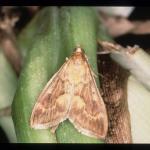
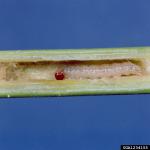 European corn borer (ECB) is a resident pest that has 2 generations per year in southern and central New England and 1 generation in northern New England. This pest prefers sweet corn but can cause damage in a wide range of crops, including bean, potato, garlic, and pepper. ECB generally does not become a pest in peppers until the appearance of the second generation in late July or early August (1400 GDD base 50°F). Most locations in MA are past or almost at 1400 GDDs (see Table 2 in Pest Alerts). The severity of ECB damage in peppers varies throughout the state. Some farms—typically in areas where farming is less dense and ECB populations have not built up— do not see much damage from this pest. In the Connecticut River Valley and in southeastern MA, an unsprayed pepper field can have anywhere from 10 to 100% of the fruit infested. In some cases, it seems that sweet corn—which ECB prefer over peppers—helps to draw ECB away; in other cases, presence of sweet corn near peppers provides no benefit at all.
European corn borer (ECB) is a resident pest that has 2 generations per year in southern and central New England and 1 generation in northern New England. This pest prefers sweet corn but can cause damage in a wide range of crops, including bean, potato, garlic, and pepper. ECB generally does not become a pest in peppers until the appearance of the second generation in late July or early August (1400 GDD base 50°F). Most locations in MA are past or almost at 1400 GDDs (see Table 2 in Pest Alerts). The severity of ECB damage in peppers varies throughout the state. Some farms—typically in areas where farming is less dense and ECB populations have not built up— do not see much damage from this pest. In the Connecticut River Valley and in southeastern MA, an unsprayed pepper field can have anywhere from 10 to 100% of the fruit infested. In some cases, it seems that sweet corn—which ECB prefer over peppers—helps to draw ECB away; in other cases, presence of sweet corn near peppers provides no benefit at all.
Life Cycle and Damage

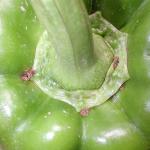 ECB larvae overwinter in stalks of corn and other host plants and pupate in the spring. Adult moths emerge in late May or early June and mate in weedy or grassy areas. The moths are about ¾” long and light brown in color with lighter bands on the wings. Females lay masses of flat, white eggs 3 to 7 days after they emerge (depending on temperature). Eggs hatch in about 5 to 7 days (100 GDDs base 50°F). After the eggs hatch, the newly emerged larvae feed on leaf tissue for a short period and then bore into stems or fruit. ECB larvae often burrow into the fruit beneath the calyx. In addition to this direct injury, ECB damage also causes premature fruit ripening. Boring holes also allow for the entry of pathogens into the fruit, which can cause fruit rot. Controlling ECB larvae before they reach the pepper fruit is essential for effectively managing this pest. Larvae vary in color from light-gray to pink but always have small, dark spots on each body segment and brown head capsules.
ECB larvae overwinter in stalks of corn and other host plants and pupate in the spring. Adult moths emerge in late May or early June and mate in weedy or grassy areas. The moths are about ¾” long and light brown in color with lighter bands on the wings. Females lay masses of flat, white eggs 3 to 7 days after they emerge (depending on temperature). Eggs hatch in about 5 to 7 days (100 GDDs base 50°F). After the eggs hatch, the newly emerged larvae feed on leaf tissue for a short period and then bore into stems or fruit. ECB larvae often burrow into the fruit beneath the calyx. In addition to this direct injury, ECB damage also causes premature fruit ripening. Boring holes also allow for the entry of pathogens into the fruit, which can cause fruit rot. Controlling ECB larvae before they reach the pepper fruit is essential for effectively managing this pest. Larvae vary in color from light-gray to pink but always have small, dark spots on each body segment and brown head capsules.
Thresholds and Chemical Control
ECB emergence is monitored using pheromone traps that attract male moths. Traps at sites across the state are checked weekly and moth counts are reported in the sweet corn section of Pest Alerts. New York and Maine also publish weekly trap counts. Historically, our recommendation was to time spray applications based on trap counts. Those recommendations were to make the first application in fruiting peppers 1 week after 7+ moths per week were trapped, and discontinue sprays 1 week after moth counts dropped below 21 moths per week, using shorter spray intervals during peak flights and when trap captures exceed 150 moths per trap weekly. ECB trap counts in sweet corn have been mysteriously very low over the last several years, despite the presence of larvae in sweet corn crops, so these spray thresholds may not be practical anymore. If you struggle with ECB in your peppers, pheromone trapping in your pepper fields may still be useful to indicate the presence of ECB and alert you to when sprays may be warranted. Choose selective/microbial products such as Bacillus thuringiensis aizawai or kurstaki strains whenever possible to preserve beneficials and reduce the chance of aphid outbreaks, which can be caused when pyrethroids are used and natural enemies are killed. For other chemical control options see the pepper insect section of the New England Vegetable Management Guide.
Biological Control
ECB can also be controlled using the parasitic wasp, Trichogramma ostriniae. ECB will invade pepper fruits that are > ½ inch across, and T. ostriniae attacks only the egg stage of ECB, so timing is critical. We recommend that you begin releases the week that flight begins and continue weekly releases for a total of 4 weeks. Release 90,000 to 120,000 wasps per acre and spread the cards out throughout your pepper block. Higher rates are needed in peppers compared to sweet corn because the tolerance for damage is virtually zero and ECB larvae attack the fruit directly. Four releases are needed because the egg-laying period for the second generation is longer than for the first generation of ECB. Fortunately, peppers are also a higher value crop and worth the extra cost. After four releases, Trichogramma will have reproduced in the field and will continue working to control ECB. Wasps can be ordered from IPM Laboratories, at www.ipmlabs.com or by phone, 315-497-2063. It may be too late to order wasps for this year, but you can plan ahead for next year. Wasps can also be used in combination with insecticides, but choose a selective material (see above) that will not kill wasps.
Mites in Solanaceous Crops
Reports of two-spotted spider mite infestations in solanaceous crops are coming in. These pests tend to ramp up in hot weather, which we’ve certainly had lately. Populations may be reduced by rainfall, which we’ve also had, though they can really be a problem in high tunnel and greenhouse grown crops that don’t have this advantage. Both broad mites and two-spotted spider mites (TSSM) affect solanaceous crops—broad mites are the most heavy-hitting on pepper, and TSSM are particularly devastating on eggplant and tomato, though they can both affect a variety of crops, including tomato, eggplant, potato, beans, and vine crops such as melons and cucumbers.
Two-Spotted Spider Mites
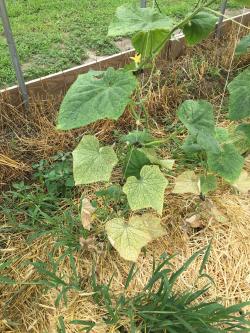
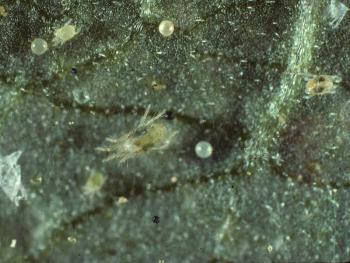 TSSM favor hot and dry conditions which also aggravate mite injury by stressing the plant. Damage is often underestimated since both the mites and the wounds they cause are difficult to see without inspecting plants closely, or until the problem becomes widespread.
TSSM favor hot and dry conditions which also aggravate mite injury by stressing the plant. Damage is often underestimated since both the mites and the wounds they cause are difficult to see without inspecting plants closely, or until the problem becomes widespread.
Identification
Adult females are tiny—about a ½ mm long—slightly orange to pale green in color, with two dark spots on their body. They are visible with the naked eye if you know what you’re looking for and where to look, but a 10x hand lens is helpful to see them. Initially, mites will feed on the undersides of leaves, but in heavy infestations, they will move to the tops of leaves and onto fruit. Large populations will produce visible webbing that can completely cover the leaves. Mites hide under the webbing, making them difficult to reach with pesticide sprays.
Life cycle
All mobile life stages can feed on plant tissue. Eggs are laid singly, up to 100 per female, during her 3- to 4-week life span. Eggs hatch into larvae in as few as 3 days. Following a brief larval stage, several nymphal stages occur before adults appear. The egg-to-adult cycle can be completed in just 7 to 14 days, depending on temperature, leading to explosions in mite population and damage. All life stages can survive the winter in high tunnels in New England, and adult females will overwinter outside as well.
Damage
Adult TSSM feed by sucking chlorophyll out of the leaves, creating blotchy pale to reddish-brown spots. Feeding injury often gives the top leaf surfaces a mottled or speckled, dull appearance. Leaves eventually turn yellow and drop. Other symptoms include distorted leaves, overall loss of plant vigor, whitening or spotting of leaves, or abnormalities on stems and fruits. On tomato, mites can damage fruit, causing small whitish spots that render fruit unmarketable.
Broad Mite
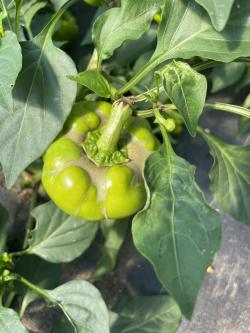
 Broad mites also have a very wide host range, including many weeds and ornamentals, but cause the most damage within the solanaceous family and are especially damaging on pepper. The source of broad mite infestations in vegetable crops is often ornamentals from greenhouses, or high tunnels where vegetable transplants were grown.
Broad mites also have a very wide host range, including many weeds and ornamentals, but cause the most damage within the solanaceous family and are especially damaging on pepper. The source of broad mite infestations in vegetable crops is often ornamentals from greenhouses, or high tunnels where vegetable transplants were grown.
Identification
Adult broad mites are even tinier than TSSM—only 0.02 mm. They’re notoriously tricky to find, even on severely symptomatic plants. Similarly to TSSM, broad mites reproduce very quickly; their life cycle takes only 7 to 8 days at 85°F.
Damage
Broad mites differ significantly from TSSM in their feeding habits and damage. Broad mites feed in the growing tip and inject a toxin as they feed that causes the growing tip to become distorted or die. Plants become severely stunted and twisted and fruit develops an unmarketable gray scar tissue. While plants infested with TSSM can recover from feeding damage after the pest has been controlled with pesticides, plants will not grow out of broad mite damage. Early in an infestation, if only a few plants are heavily infested, pull and bag those plants and treat the remaining plants.
Cultural control
Outbreaks may be worsened by excess nitrogen fertilization or by the use of broad-spectrum insecticides that kill naturally occurring mite predators. Overhead irrigation or prolonged periods of rain can help reduce populations. Keep weeds under control. Control broad mites in ornamentals if you grow ornamentals and vegetable transplants in the same structure.
Biological control
Preventative releases of the predatory mite, Phytoseiulus persimilis, may suppress TSSM populations in vegetable fields, as they do in strawberry fields. Amblyseius fallacis is a predatory mite that is widely used in greenhouses. See Biological Control for Insects and Mites in the Transplant Insect and Mite Management section of the New England Vegetable Management Guide for more information on using biological controls in greenhouses and high tunnels and for a list of suppliers.
Chemical control
Early or preventative control is essential for controlling both broad mites and TSSM, as populations can explode quickly. Use selective products whenever possible. Selective products which have worked well in the field include:
- Agri-Mek (Group 6, 7d PHI): abamectin, derived from a soil bacterium. Must be mixed with non-ionic activator type wetting, spreading,and/or penetrating adjuvant. Labeled to control TSSM & BM in solanaceous crops (and TSSM only in cucurbit crops). Can be used in greenhouses but only on tomato crops.
- Acramite (Group 25, 3d PHI): bifenazate, a contact nerve poison with a long residual. TSSM only (not effective on broad mites). Labeled for solanaceous (eggplant, pepper, and field-grown tomato) and cucurbit crops.
- Movento (Group 23, 1d PHI): spirotetramat. Active primarily by ingestion. Systemic. Labeled for control of BM and suppression of TSSM in solanaceous crops. Mainly affects immature stages. Not for use in enclosed structures, such as greenhouses or planthouses.
- Oberon 2SC (Group 23, 1d PHI for solanaceous, 7d PHI for cucurbits): spiromesifen. Active on contact and by ingestion. Translaminar. TSSM & BM. Mainly affects immature stages. Labeled to control TSSM & BM in solanaceous crops (and TSSM only in cucurbit crops).
Two other selective products are:
- Kanemite (Group 20B, 1d PHI): acequincyl. Knockdown and residual control. Labeled for TSSM & BM in field and greenhouse-grown solanaceous and cucurbit crops.
- Portal XLO (Group 21A, 1d PHI): fenpyromixate. Stops feeding immediately after application. Mites die in 3 to 7 days. Labeled for TSSM & BM in solanaceous and cucurbit crops.
OMRI-listed products include insecticidal soap (M-Pede) and horticultural oils (e.g. Trilogy, Suffoil X, and Golden Pest Spray Oil). These can be effective, especially if utilized early and regularly and with good leaf coverage. The bioinsecticides Met52, Grandevo, and Venerate (all 0 PHI) are also labeled.
See Insecticides Listed by Trade Name, Table 27 and the appropriate crop section in the New England Vegetable Management Guide for more details on pesticides.
With most miticides (but not bifenazate, which has a long residual), use 2 applications approximately 5 to 7 days apart to help control immature mites that were in the egg stage and protected during the first application. Because mites reproduce so quickly, populations can easily develop resistance to products; alternate between products after 2 applications to help prevent or delay resistance. Check product labels for specific use restrictions.
--Written by the UMass Extension Vegetable Program
News
39th Massachusetts Tomato Contest to be Held on August 20
The 39th Massachusetts Tomato Contest will be held at the Boston Public Market on Tuesday, August 20. Tomatoes will be judged by a panel of experts on flavor, firmness/slicing quality, exterior color and shape. Always a lively and fun event, the day is designed to increase awareness of locally grown produce.
Open to commercial farmers in Massachusetts, growers can bring tomatoes to the market between 8:45 am and 10:45 am on August 20 or drop their entries off with a registration form to one of the regional drop-off locations on Monday, August 19. Drop off locations include sites in South Deerfield, Southboro, North Easton and West Newbury. These tomatoes will be brought to Boston on Tuesday.
For complete details, including drop off locations, contest criteria, and a registration form, click here. Be sure to include the registration form with all entries.
The Massachusetts Tomato Contest is sponsored by MDAR and New England Vegetable and Berry Growers Association, in cooperation with the Boston Public Market. Please consider participating to showcase one of the season’s most anticipated crops!
Questions? Contact David Webber, David.Webber@mass.gov.
News
MDAR Agricultural Composting Improvement Grant Program (ACIP) Now Open - Deadline August 1
The goal of MDAR’s Agricultural Composting Improvement Grant Program is to help agricultural composters improve the overall management of their agricultural composting operations and facilitate on-farm compost use. Awarded grants can provide 75% reimbursement (up to $75,000) for on-farm composters for projects or equipment which improves efficiency or environmental conditions of agricultural composting sites. Click here for more information.
Participate in Organic High Tunnel Vegetable Study
If you are growing organic vegetables in a high tunnel, we want to connect with you! The University of Minnesota and University of New Hampshire are partnering to conduct on-farm research about the performance of legume cover crops in organic high tunnel vegetable rotations in the Midwest and Northeast regions. The goal of this project is to enable organic high tunnel growers to reduce their dependence on purchased composts and manures by using nitrogen-fixing legume cover crops to support soil fertility, productivity, and sustainability.
We are currently recruiting organic high tunnel growers to receive cover crop seed and participate in the on-farm research trials, which will begin in fall 2024 for overwinter cover crops and spring 2025 for spring/summer covers. We have two levels of participation available, so you can choose the level of commitment that works for you.
Informational webinar:
When: Tuesday, July 30, 7:30pm EST
Where: Zoom
Click HERE to watch a recording at the previous information session.
Sign up to learn more about the trial at z.umn.edu/hightunnelcovercroptrial. We will send the webinar link and a calendar invitation to everyone who signs up. Hope to see you there!
Questions? Contact Becky Sideman, becky.sideman@unh.edu.
Events
Tillage Reduction Systems and Equipment: Living Mulch and Strip-Till at Atlas Farms - Deerfield, MA
When: Thursday, July 25, 4-6pm
Where: Atlas Farm (~1 mile south of farm office), 595A River Rd, Deerfield, MA 01342
Registration: Free! Please register in advance so we can plan for food. Click here to register.
Come check out Atlas Farms' 3-acre experiment with strip-tilled winter squash into a perennial clover living mulch, and living clover/rye pathways in 5 acres of tomatoes. We'll look at a no-till drill, strip-till equipment, and strip-cultivation equipment. Atlas' trials have implications for tillage reduction and soil health for conventional and organic growers at all scales. There will be a light dinner at 6 PM.
This event is co-sponsored by CISA, Momentum Ag, Hampshire/Hampden/Franklin County Conservation District, and UMass Extension.
Water & Climate Change Twilight Meeting at Bardwell Farm – Hatfield, MA
When: Friday, August 2, 2024, 5-7pm, with dinner and discussion to follow
Where: Bardwell Farm, 49 Main St., Hatfield, MA 01038
Registration: Free! Please register in advance so we can order enough food. Click here to register.
Join UMass Extension and CISA for a climate-themed twilight meeting at Bardwell Farm in Hatfield, MA!
- Lisa McKeag will share findings from her recent water quality survey of farms around MA and discuss potential risks and impacts of weather and climate change and rising year-round temperatures on agricultural water quality.
- Harrison Bardwell will show off his new automated irrigation system, and discuss irrigation practices and funded projects around the farm.
- Sue Scheufele will discuss increasing pest risks caused by a hotter climate on vegetable pests including an on-farm trial for managing Phytophthora blight in peppers hosted by Bardwell Farm.
1 pesticide recertification credit is available for this program.
This event is co-sponsored by CISA as part of their Adapting your Farm to Climate Change Series.
Save the Date! UMass Research Farm Field Day - South Deerfield, MA
When: August 13, 2024, time TBD
Where: UMass Crop & Livestock Research & Education Farm, 89 River Rd., South Deerfield, MA
Registration: Coming soon!
Come learn about all the research being done by students and faculty across CNS and by UMass Extension on a tour of the farm. Topics include pollinator habitat, bee health and disease ecology, novel cover cropping strategies, intercropping to reduce greenhouse gas emissions, genetic basis of flowering traits in agriculture, and vegetable variety trials including heat-resistant lettuce varieties for summer production.
Bees and Beyond: Pollinators at the Arboretum
When: Saturday, August 18, 2:00-3:30pm
Where: Arnold Arboretum, 125 Arborway, Boston, MA 02130
Registration: Free. Registration is required. Click here to register.
Join pollinator expert and UMass Extension educator Nicole Bell for a walk through the Arboretum’s meadows to find bees and other pollinators in their natural habitat. Nicole will use a sweep net to find and catch bees in the landscape so participants can see them up close, while we talk about the most common bees found in Massachusetts, where they live and what they eat, and the importance of places like the Arboretum for pollinator conservation.
Field Walk at Siena Farms - Sudbury, MA
When: Wednesday, August 21, 2024, 4-6pm
Where: Siena Farms, 113 Haynes Rd, Sudbury, MA 01776
Registration: Free! Please register in advance, for food ordering purposes. Click here to register.
Join us for a field walk at Siena Farms! Someone from the farm will discuss their sunflower production, and the UMass Extension Vegetable Program will lead a pest walk. Nicole Bell, UMass Pollinator Extension Educator, will talk about sunflower pollination. Light dinner and refreshments will be served at the end, with plenty of time to talk with fellow growers!
1 pesticide recertification credit is available for this program.
This event is funded by a grant from the Massachusetts Department of Agriculture.
Twilight Meeting: Climate Impacts on Weed Management and Soil Health - South Deerfield, MA
When: Tuesday, October 8, 2024, 4-6pm, with a light supper to follow
Where: UMass Crop & Livestock Research & Education Farm, 89 River Rd., South Deerfield, MA, 01373
Registration: Free! Please register in advance so we can order enough food. Click here to register.
How are climate change and hotter temperatures affecting our soils? Often, practices like reducing tillage and cover cropping are recommended to improve soil health, reduce risk of topsoil loss and enhance resilience to drought and flood—practices that can also affect weed management. UMass Extension will discuss general impacts of climate change on soil health and highlight current research on updating recommendations for planting timing and overwintering survival of cover crop species in MA. Maria Gannett, UMass Extension Weeds Specialist, will relate these strategies to how they can impact weed management.
1 pesticide recertification credit is available for this program.
This event is co-sponsored by CISA as part of their Adapting your Farm to Climate Change Series.
Save the Date! Gaining Ground Farm Tour
When: Thursday, October 17, 2024, 4-6pm
Where: Gaining Ground, 341 Virginia Rd., Concord, MA 01742
Join New Entry and UMass Extension for a farm tour of Gaining Ground Farm in Concord, MA!
Registration and event details coming soon.
New England Vegetable & Fruit Conference - Registration Now Open!
When: Tuesday - Thursday, December 17-19, 2024, 8am-6pm daily
Where: Doubletree Hotel, 700 Elm St., Manchester, NH 03101
Registration: Before November 30, $115/person, or $85 for additional attendees if registering as a group. Students $50. Registration capped at 1,400. Click here to register.
The NEVF Conference includes more than 25 educational sessions over three days, covering major vegetable, berry and tree fruit crops as well as various special topics. A Farmer-to-Farmer meeting after each morning and afternoon session will bring speakers and farmers together for informal, in-depth discussions on certain issues. The extensive trade show has over 120 exhibitors.
Vegetable Notes. Maria Gannett, Genevieve Higgins, Lisa McKeag, Susan Scheufele, Alireza Shokoohi, Hannah Whitehead, co-editors. All photos in this publication are credited to the UMass Extension Vegetable Program unless otherwise noted.
Where trade names or commercial products are used, no company or product endorsement is implied or intended. Always read the label before using any pesticide. The label is the legal document for product use. Disregard any information in this newsletter if it is in conflict with the label.
The University of Massachusetts Extension is an equal opportunity provider and employer, United States Department of Agriculture cooperating. Contact your local Extension office for information on disability accommodations. Contact the State Center Directors Office if you have concerns related to discrimination, 413-545-4800.
